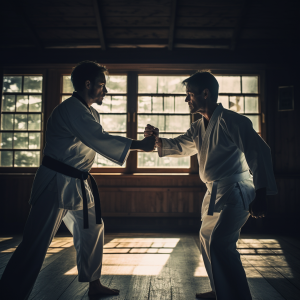 During the process of skill acquisition or when learning a new discipline, the pursuit of knowledge often extends further than its apparent purpose.
During the process of skill acquisition or when learning a new discipline, the pursuit of knowledge often extends further than its apparent purpose.
Consider the art of language—it is far more than the mere exchange of words in a debate, for example. While the concept of debate is a vital piece of communication, it is not the paramount purpose of language.
While some wield language as a tool to convincingly present their point, its depth goes far beyond mere persuasion. It encompasses the ability to create poetry that stirs the soul, narrate tales that provoke the imagination, and communicate with emotional frequencies for both positive and negative results.
Similarly, the pursuit of martial arts is a multidimensional journey. Yes, it involves the honing of physical capabilities and the art of self-defense. Yet, the experience of training in martial arts encapsulates much more than the tactical execution of movement; it includes diligent planning and strategizing as well.
Within these two seemingly different fields lies a particular aspect of interest — one that draws parallels between language’s ability to engage in drawing out reaction and emotion and the precise, rehearsed techniques of a skilled martial artist. They both possess the acumen to dissect their audience or opponent, identifying weaknesses within an attack and artfully employing those vulnerabilities against them. This ability to utilize purposeful manipulation and strategic analysis tactics is shared amongst effective communicators and skilled martial artists alike.
The Power of Manipulation
Within the concept of effective communication and martial arts, a skilled practitioner can harness the power of purposeful manipulation tactics.
While a writer might use words and rhetoric to sway opinions and evoke emotions, martial artists can employ calculated movements and strategic analysis to gain an advantage in combat. Both navigate the terrain of manipulation with intent—be it to convince, influence, or gain an upper hand.
Someone who is skilled in communication strategically structures their message, leveraging the suggestions of language and emotion to enthrall their audience. Similarly, martial artists tactically maneuver within their environment, analyzing their opponent’s vulnerabilities, exploiting their weaknesses, and employing techniques mastered through practice and discipline. Both showcase the art of purposeful manipulation—a corroboration between words and movements, where the adept practitioner navigates the intricacies to achieve their desired outcome.
So, how would an effective communicator and an adept martial artist manipulate their audience/opponent?
Strategic Planning and Preparation: Both communicators and martial artists engage in meticulous planning and preparation. Communicators might research their audience, create specific messages, and anticipate potential responses. Similarly, martial artists study their opponents, analyze their styles, and devise strategies before engaging in combat. They analyze their environment, potential challenges, and anticipate potential responses as well.
Adaptability in Execution: Effective communicators adjust their approach based on audience reactions or unforeseen circumstances that arise. Martial artists dynamically adapt their techniques in response to their opponent’s movements during combat.
Exploiting Weaknesses: Communicators that focus on debate or “hot topics” aim to find weaknesses in opposing arguments or emotions to persuade the audience effectively. Martial artists seek out vulnerabilities in their opponent’s defenses or movements to gain a physical edge in combat. This is perhaps one of the most important parts of strategizing as an adept martial artist can not only exploit their opponents’ weaknesses but also create an offense/defense that disables their strengths.
 Emotional Manipulation: Communication masters appeal to the emotions of their audience, while martial artists maneuver to create openings or weaknesses in their opponent’s defense. Once their opponent realizes what is happening, it creates an emotional response and exposes their vulnerabilities. It is a subset of exploiting weaknesses and utilizing them against the “opponent”.
Emotional Manipulation: Communication masters appeal to the emotions of their audience, while martial artists maneuver to create openings or weaknesses in their opponent’s defense. Once their opponent realizes what is happening, it creates an emotional response and exposes their vulnerabilities. It is a subset of exploiting weaknesses and utilizing them against the “opponent”.
Mind Games and Psychological Tactics: Both communicators and martial artists employ mind games and psychological tactics. Communicators might use rhetoric or framing to influence perceptions, while martial artists can use psychological pressure to unsettle their opponents.
Strategic Timing and Control: Timing is paramount in delivery for maximum impact, controlling the flow of communication. Similarly, martial artists control the pace of combat, strategically timing strikes and techniques to gain an advantage.
Evolving Strategies: For both communicators and martial artists, adaptability is vital. Effective communicators adapt to changing audiences or contexts, while martial artists evolve their techniques based on opponents or combat scenarios.
Within the fields of communication and martial arts, planning, adaptability, and strategic analysis is vital to sway the outcome in their favor. Both utilize manipulation tactics (some of which can be more difficult to identify) to accomplish part of this analysis.
The Power of Strategic Analysis
We know that effective communicators possess the knowledge to manipulate words for their purpose – and similarly, trained martial artists can turn a situation to their benefit in a few movements. While a writer may utilize research, interviews, or historical documents to strategically create a literary “attack”, how does a martial artist learn the comprehensive art of strategic analysis beyond manipulation tactics?
One of the simplest ways to begin to think tactically is to use a SWOT (Strengths, Weaknesses, Opportunities, and Threats) analysis. This is a standard business term and is typically used as a planning strategy for companies who are entering the market, changing something within their framework, or creating something new. It is an effective way to dive into identifying potential challenges before devising a plan.
Albert Humphrey of the Stanford Research Institute created this method in the 1960s during a study conducted to identify why corporate planning consistently failed (Schooley, 2023).
While this strategizing concept was created within the corporate world, a SWOT analysis is particularly effective when used on individuals. It exposes vulnerabilities that might not easily be identified at first glance and is an excellent way to begin understanding how the process of strategic analysis works. While you may find yourself analyzing your audience or your opponent, simply employing one or two of the techniques mentioned won’t do. A full, comprehensive analysis includes all four and gives the full picture – when proper planning and strategizing takes place.
 Think about the process that a writer undergoes as they’re beginning to write a book – gathering information about their projected audience, what they enjoy, what their triggers are collectively, etc. Just as a writer devises a plan to utilize strengths, weaknesses, opportunities, and threats within their audience, a skilled martial artist analyzes their opponent, environment, potential challenges, etc. to exploit and take advantage of weaknesses.
Think about the process that a writer undergoes as they’re beginning to write a book – gathering information about their projected audience, what they enjoy, what their triggers are collectively, etc. Just as a writer devises a plan to utilize strengths, weaknesses, opportunities, and threats within their audience, a skilled martial artist analyzes their opponent, environment, potential challenges, etc. to exploit and take advantage of weaknesses.
As we mentioned previously, exploiting weaknesses is perhaps one of the most important parts of a strategic analysis. Manipulation of your audience or your opponent becomes much easier once you know where they are most vulnerable. Pairing manipulation tactics with strategic analysis creates a powerhouse, for both the experienced communicator and the skilled martial artist.
The intricate connection between language’s power to evoke reactions and emotions and the martial artist’s ability to carefully manipulate and analyze their opponent is a unique and fascinating world — to explore the intertwined aspects of linguistic finesse and martial arts knowledge, where manipulation and strategic analysis work together.
The parallels drawn between the power of words and the meticulous analysis of an opponent’s movements reveal a fascinating convergence. It highlights not just the similarities but also the complementary nature of these seemingly differing fields. Ultimately, it underscores a fundamental truth—that mastery in both communication and martial arts isn’t solely about individual capabilities; it’s about the harmonious fusion of intellect, strategy, and execution, inviting practitioners to explore the depths of their chosen field and emerge as adept navigators of their environment.
References
Schooley, S. (2023). What is a SWOT Analysis (and when to use it). Business News Daily. Retrieved from https://www.businessnewsdaily.com/4245-swot-analysis.html






